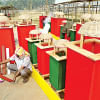Arun Chakraborty, creator of ‘Lal Paharir Deshe Ja,’ no more

The celebrated creator of the iconic song "Lal Pahari Deshe Ja", Arun Chakraborty, has passed away. He breathed his last at 12:10am today at his residence on Farm Side Road in Chinsurah, Hooghly district, West Bengal. The eminent artiste was 80 years old. The news of his passing was confirmed to Prothom Alo by family friend Saptarshi Ray Bardhan.
The mortal remains of Arun Chakraborty were transported from his residence to Chinsurah Rabindra Bhavan, where they were placed on a public platform for admirers to pay their final respects.
The funeral rites are set to take place at Shyam Babu's Ghat. At his home on Farm Side Road in Chinsurah, he was surrounded by his wife, two sons, daughter-in-law, and grandchildren.

According to reports, Arun Chakraborty was in relatively good health. Just the previous day, he attended the Junglemahal event at Kolkata's Mohor Kunja. However, family members shared that he developed a slight cold afterwards. His daughter-in-law, Sudeshna Chakraborty, revealed that he had been struggling with lung-related issues since the onset of the COVID-19 pandemic.
Born on September 16, 1946, in Bagbazar, Kolkata, Arun Chakraborty spent the last few decades of his life in Chinsurah, where he had been residing since 1990. Although professionally a civil engineer and a former government employee, Arun eventually embraced his passion for poetry, transforming into a full-time poet. A graduate of Shibpur Engineering College, he was deeply devoted to writing, reading, and recitation.
His claim to fame came through his iconic poem, "Lal Paharir Deshe Ja, Ranga Matir Deshe Ja", which later became a beloved song, resonating with music lovers across both Bengals. Immersed in Bengali folk culture, Arun often journeyed to hills, forests, and tribal regions, drawing inspiration for his works.
In an interview with Prothom Alo, Arun revealed the origins of his iconic piece. Written in 1972 in Srirampur, the poem was inspired by the scent of mahua flowers. "I was walking past a station and suddenly caught the fragrance," he recalled. Decades later, the poet remains immortal in the hearts of admirers through the timeless melody of "Lal Pahari."
While sitting at a railway station, Arun Chakraborty was struck by the sight of a blooming Mahua tree. The image left him in awe. He pondered, "Why is this tree here? It belongs to the heart of the forest. Surely, this is the queen of the wilderness. Its place is not here, at this railway station—it deserves the unspoiled beauty of nature."

Inspired by the moment, Chakraborty penned a poem beginning with the lines, "Hai dekh go, tui ekhane kene? O tui 'Lal Paharir Deshe Ja,' 'Ranga Matir Deshe Ja.' Hethake tuke manaichhe naire, ikkebare manaichhe naire…"
Initially titled "Srirampur Istishane Mahuagachhta" (The Mahua Tree at Srirampur Station), the piece gained popularity among Bauls. At their request, Chakraborty reworked the poem, giving it a fresh tune and expanding its narrative under the now-famous title "Lal Paharir Deshe Ja."
Arun Chakraborty embraced a life of spontaneity and wanderlust, with the free-spirited ethos of a Baul. Despite holding a prominent position in the engineering sector, his true connections were forged outside his professional circle. His companions were often artistes, street vendors, flower sellers, fishermen, bookshop owners, and roadside food stall operators—a fact he candidly shared during a conversation.
Reflecting on his journey, he remarked, "I've spent my life as a wanderer. From the peaks of the Himalayas to the southern tip of Kanyakumari, from Somnath's shores to Kohima's hills—I found my happiness in the nomadic path of a Baul."
Yet, Chakraborty also valued solitude deeply. Periods of complete isolation were essential to him, during which he immersed himself in meditation, temporarily cutting ties with the outside world to retreat into his inner self.
However, Arun Chakraborty made it a point to visit Kolkata every winter. His friendships and gatherings were primarily with younger individuals. His lifestyle was extremely simple—he always carried chocolates in his pocket. Whenever he met someone, he would greet them with a handshake and gift them a chocolate as a gesture of welcome.
The talented artiste wrote extensively on various topics, ranging from politics and education to folk music. His writings often reflected the lives and struggles of ordinary people, with a particular focus on marginalised communities. His work earned him India's National Award.

 For all latest news, follow The Daily Star's Google News channel.
For all latest news, follow The Daily Star's Google News channel. 









Comments